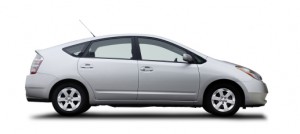 On this page, we discuss the following topics related to “greener cars”:
On this page, we discuss the following topics related to “greener cars”:
- Hybrid electric vehicles
- Hybrid types
- Regenerative braking
- Electric vehicles
- Batteries
- Fuel cells
- Older vehicles
Click a link in the list above to jump to that topic on this page.
Vehicles are much cleaner running than they were 20 years ago. When buying a new vehicle, it is easy to buy green. Evaluate the impact of your vehicle on the environment. Before you buy a vehicle ask yourself The Big Three questions (1):
- Does it have to be this big? Evaluate your needs carefully. Larger, heavier vehicles use more materials and require more power to drive. As a result, most have larger engines with poor fuel economies.
- How is the fuel economy? The amount of CO2 emitted by a vehicle is directly proportional to the amount of fuel it uses. Every litre of gasoline that is burned produces about 2.3 kg of CO2. (2) The better the fuel economy, the fewer the GHG emissions per kilometer. Bigger savings at the pump, too.
- What is the emission rating? Look for the Vehicle Emission Control Information sticker under the hood. It will tell you if the engine meets national low-emission standards (NLEV). Some dealerships remove these stickers. If so, ask a salesperson for vehicle emission information.
Hybrid electric vehicles (HEV)
Hybrid electric vehicles combine a gasoline-powered combustion engine with a battery-powered electric motor, resulting in twice the fuel economy of a conventional vehicle (3).
According to Manitoba Conservation, other HEV advantages include:
- Reduced smog-forming pollutants
- Reduced resource consumption and our dependency on fossil fuels
- Competitive pricing
- Exceptional gas mileage
- Similar safety and comfort features compared to conventional vehicles.
The combination of electric and combustion engine also offers the power, extended range and convenient refueling capability of conventional vehicles. The inherent flexibility of HEV’s has lead the Clean Cities Program to identify them as excellent choices for both fleet and personal transportation (4).
There are a number of hybrid electric vehicle models sold in Manitoba.
Hybrid types
There are three basic types of hybrid:
- Series – In a series HEV, the internal combustion (IC) engine never directly powers the vehicle. Rather, the IC engine drives the generator, and the generator can either charge the batteries or power an electric motor that drives the wheels (5). In other words, all the torque used to move the vehicle comes from the electric motor. The benefit of the series hybrid is that the IC engine drives the generator to run at optimal efficiency (6).
- Parallel – In a parallel system, the IC engine, the batteries and the electric motor connect to the transmission. As driving conditions change, both the IC engine and the generator / motor can supply power to the wheels, switching back and forth as needed (7). Power generated by the IC engine is typically used for highway driving, while the electric motor is used to assist in accelerating the vehicle (8).
- Split – In split HEVs there is no connection between the IC engine and the electric components. The engine drives one axle and the electric motor drives the other (9).
Regenerative braking
Hybrid electric vehicles (HEV) use regenerative braking to recapture braking energy (10). When the vehicle brakes to stop, the electric motor works “in reverse”, transferring the power created from braking to the generator. Electricity produced during this process can be stored in batteries or in ultra-capacitors. The recycled power can be reused to drive the wheels or displace engine operation so less fuel is burned, leading to fewer emissions.
Electric vehicles
For more information on electric vehicles, contact the Manitoba Electric Vehicle Association (MEVA).
Electricity can be used as a transportation fuel in two ways:
- Stored for use in a battery
- Produced by an electrochemical reaction in fuel cells
Batteries
When used to drive electric vehicles (EV’s), batteries are the typical storage unit or “fuel tank” for electric power. Like a fuel tank, batteries have a limited range. But instead of filling up at a gas station, the vehicle can be recharged by plugging into a recharging unit. Some electric vehicles can plug into any 110V household outlet!
Fuel cells
Electricity is produced in fuel cells by electrochemical reactions based on hydrogen. Hydrogen and oxygen are fed into a proton exchange membrane fuel cell stack and produce enough electricity to power an automobile. The production of electricity using fuel cells takes place without combustion. Fuel cell vehicle development is an ongoing process. Electric fuel cell vehicles produce only two tailpipe emissions: heat and water.
However, hydrogen is not a natural resource. It must be manufactured with consequent energy losses. READ MORE about hydrogen.
Older vehicles
Older vehicles typically get poorer fuel economy and emit more nitrous oxides (NOx) and hydrocarbons (HC) than new ones. Vehicles built in 1995 or before emit 20 times more hydrocarbons than a 2001 vehicle, and 65 times more than a 2007 vehicle. (11)
Consider trading in your old beater for a newer, smaller, more economical vehicle.




